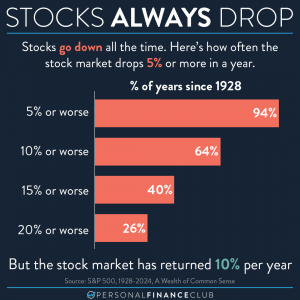
I often get asked, “which index funds should I buy”? Well, here’s an answer! These ten portfolios are all functionally identical. They contain (nearly) the same stocks and bonds in the same proportions. Let’s break down some of the details:
• How do I read this table? Each row represents an entire investment portfolio. So if I had $1M to invest, I would pick exactly one row and dump all my money into the funds listed in the proportions listed.
• What does the “type” column mean? That indicates whether those ticker symbols are ETSs or Mutual Funds. Everything on this page is an index fund.
• Which row should I choose? If you’re going with the mutual fund version, make sure to match the fund provider to your brokerage account. (i.e. only buy Vanguard mutual funds inside a Vanguard account).
• Why would I choose Mutual Funds over ETFs? The simplicity of investing once per day in dollars and the ability to setup automated investments.
• Why would I choose ETFs over Mutual Funds? Better portability between brokerages (if you transfer), better availability in different brokerages or different countries.
• Where are Fidelity’s ETFs? Fidelity doesn’t have their own ETF index funds, but all ETFs trade free at Fidelity, so feel free to choose any of the ETF options.
• Should I invest in more than one of these portfolios? No. That’s just adding complexity without adding diversification. Each numbered portfolio is already a fully diverse
• Is a single fund, like VFIFX, really diversified enough? Yes. It’s a single ticker symbol, but inside it contains thousands of stocks and thousands of bonds, diversified across the globe.
• How do I learn more about this? We’re having a HUGE SALE on my index fund course AND my money course starting tonight at MIDNIGHT! Stay tuned and check my link in bio for more details.
As always, reminding you to build wealth by following the two PFC rules: 1.) Live below your means and 2.) Invest early and often.
-Jeremy

 September Sale!
September Sale! 



